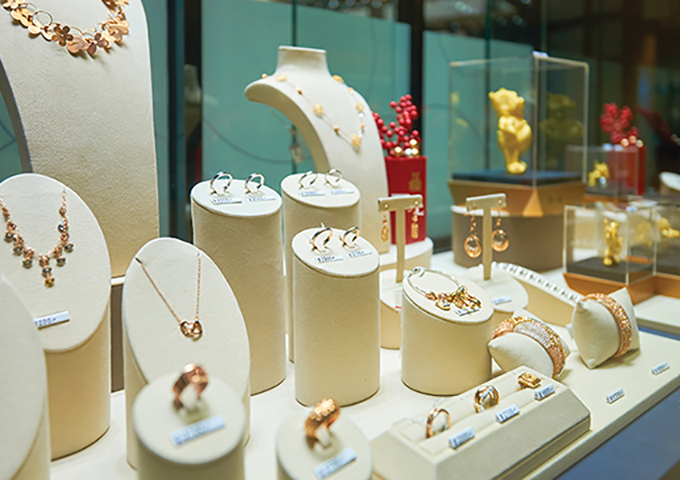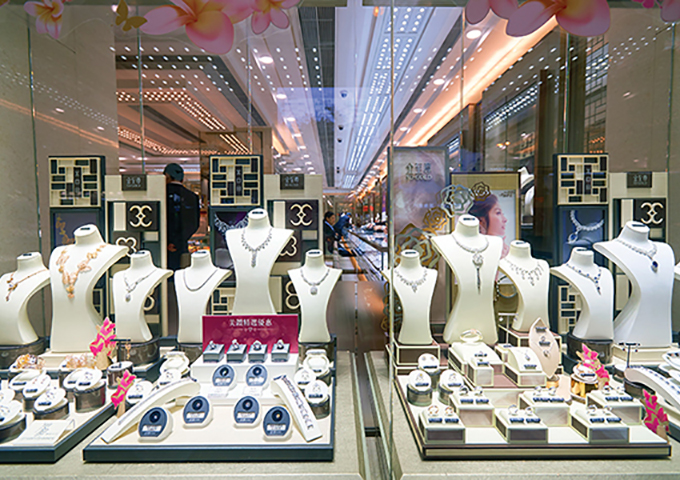Hong Kong association heads weigh in on the impact of the pandemic on the city’s gem and jewellery industry and reveal their vision for the sustainable growth of the sector.
Encouraging jewellery sales and exports indicate that Hong Kong is slowly but surely regaining its footing after the main onslaught of the Covid-19 pandemic. The city’s industry leaders share with JNA the factors that will affect business moving forward.
Bronia Yip is the chairwoman of the Hong Kong Jewelry Manufacturers’ Association (HKJMA). The first woman to head HKJMA, she is the founder of Goldiaq Creation Ltd. Louis Cheung King Yau, managing director of Edelweiss Jewellery Co Ltd, leads the Hong Kong Jewellery & Jade Manufacturers Association (HKJJA) as its chairman.
JNA: How did the Covid-19 pandemic affect Hong Kong’s gem and jewellery industry?
HKJMA’s Bronia Yip: The Covid-19 pandemic affected global economies for over 18 months, hurting many businesses, especially the jewellery and gem sectors that rely heavily on exhibitions for their wholesale and export business. A challenge our industry had never encountered before, it forced us to completely change the way we do business. The pandemic altered the traditional order-taking pattern, fostering online transactions and accelerating the digitalisation of business operations. I am deeply proud that the Hong Kong jewellery sector was not intimidated by the challenges but quickly reoriented its focus and adapted to the ever-evolving circumstances.
JNA: How is Hong Kong's jewellery sector faring in the post-lockdown era?
HKJJA’s Louis Cheung: The Covid-19 pandemic dealt a heavy blow to the Hong Kong jewellery industry, bringing business to a complete standstill and slashing jewellery exports by 70 to 80 per cent. But since June 2021, the US market has been showing signs of recovery, reinforcing export growth momentum. From January to October 2021, Hong Kong’s total exports of fine jewellery were valued at over HK$60 billion (around US$7.7 billion), a 59 per cent increase year on year. This is a testament to the perseverance, calm, resilience, determination and hard work of Hong Kong jewellery stakeholders in the face of adversity.
JNA: What should Hong Kong do in order to sustain business growth?
HKJJA’s Cheung: Having a forward-looking strategy is critical to success. Hong Kong should capitalise on its strengths and expertise, namely providing the world with mid- to high-end jewellery. We cannot successfully compete in the lower end of the market.
Moreover, we have been servicing Western jewellery markets for decades. It is time for Hong Kong to also look to Asia. Hong Kong’s jewellers should head north to further explore the mainland market. China’s jewellery industry has matured in recent years and offers plenty of business opportunities that we have yet to tap. Southeast Asian markets likewise hold strong potential for growth. That said, we cannot ignore our traditional markets, including the US. But a single-direction business model no longer works. While securing our established markets, we need to reach out to new ones.
HKJMA’s Yip: Further engagement with Southeast Asia and the Greater Bay Area of China is essential, particularly since we expect more favourable policies and supportive measures to be formulated for jewellery-related businesses. China is one of the world’s largest economies with a huge purchasing power – opportunities abound in its relatively cheaper costs and its potential as a market for high-end jewellery items. We also welcome the development of the world-class rough diamond and gemstone processing centre in Macau under the Hengqin-Guangdong-Macao cooperation zone. These reinforce the strategic importance of China in Hong Kong’s growth strategy.
JNA: How can Hong Kong jewellers make further inroads in the mainland?
HKJJA’s Cheung: The China market is too big and diverse for a one-size-fits-all approach. We should focus strategically on certain regions and gain a foothold there before venturing to the next area. We do the same in the US where we are active in specific states rather than the whole country. Most of Hong Kong’s jewellers are small and medium enterprises; the best strategy is to work closely with local partners to gain a stronger foothold on the mainland.
Since the Greater Bay Area is close to Hong Kong, it is an ideal gateway to the mainland. The area is 10 times the size of Hong Kong and has a total population of over 100 million people. Hong Kong jewellers should have a base in Shenzhen and Panyu, from which they can expand to other cities that have jewellery requirements.
JNA: What are your priorities this year?
HKJMA’s Yip: As chairwoman of HKJMA for 2021-2023, I shall take a pragmatic and proactive approach to lead the team in overcoming difficulties and reviving our industry in the long run. HKJMA will continue to promote and facilitate digitalisation and value creation to support the sustainable development of our industry. Our J-Hub initiative encourages younger generations’ involvement in the four key pillars of Hong Kong jewellery – Design, Knowledge, Craftsmanship and Assurance – in keeping with our motto, Hong Kong Jewelry, Global Brilliancy.
HKJJA’s Cheung: It is important to help our members know more about China and impress upon them that this is where the future of the jewellery industry lies. The mainland market has matured; affluence has grown; ease of business has improved. HKJJA will help its members venture into this market. I also intend to inspire our members to fully leverage digital initiatives that can provide more business prospects at lower costs. What Hong Kong jewellers have is history and experience; what we lack are branding strategies. The influence and integrity of our association can help add value to our products, enhance our image and boost the confidence of our customers. After all, jewellery from Hong Kong has always had a very good reputation.
JNA: What is your outlook for 2022?
HKJJA’s Cheung: I believe the global jewellery industry can return to 70 to 80 per cent normalcy this year. The introduction of more effective medication and vaccines will mitigate the pandemic and its impact on the economy and our industry. When that happens, we can expect business to rebound with confidence. This will lead to the resumption of exhibitions, which are critical to creating leads for the trade. Physical shows are getting back on track, with more end-users visiting fairgrounds. Companies should therefore adopt a target-oriented approach at fairs. Notably, the digital tide will keep sweeping the industry – exhibitions will integrate online components in their business models, while social media and influencers will continue to propel business growth.











